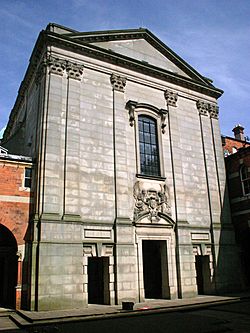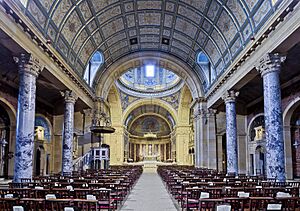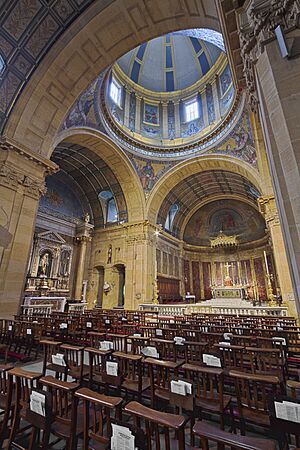Birmingham Oratory facts for kids

Cardinal Newman Memorial Church
|
|
| Monastery information | |
|---|---|
| Full name | Oratory of St. Philip Neri |
| Order | Congregation of the Oratory |
| Established | 1849 |
| Dedicated to | Immaculate Conception |
| Diocese | Roman Catholic Archdiocese of Birmingham |
| People | |
| Founder(s) | Saint John Henry Cardinal Newman, Cong. Orat. |
| Prior | The Very Revd Ignatius Harrison, Cong.Orat., Provost |
| Architecture | |
| Heritage designation | Grade II* listed building |
| Architect | Edward Doran Webb |
| Style | Baroque |
| Groundbreaking | 1850 (original), 1907 (current) |
| Completion date | 1852 (original), 1910 (current) |
| Site | |
| Location | Birmingham |
| Country | England |
The Birmingham Oratory is a special Catholic community and church in Birmingham, England. It was started in 1849 by John Henry Newman. This was the first place in England for a group called the Oratory of St. Philip Neri. This group follows the ideas of St. Philip Neri, who lived in Italy in the 1500s.
The main church at the Oratory is often called the Oratory Church. It is also known as the Parish Church of the Immaculate Conception. Today, it is a special national place of honor for Newman.
Contents
History of the Oratory
Saint John Henry Newman founded the Birmingham Oratory. After he became a Catholic, he looked for a new way to live his religious life. He felt drawn to the community started by St. Philip Neri in Italy. In 1845, Newman went to Rome and got permission from Pope Pius IX to start an Oratory community in England.
Newman came back to England in 1847. He gathered a small group of followers who wanted to live this way too. They first found a home in Birmingham at the Church of St. Anne. This became the first Oratorian community in England in 1849. Later, they found a better spot in Birmingham. They started building a new home and church there. The Oratory community moved into their new buildings in 1852. The church became a local parish church and has served the community ever since.
When a second person from the Oratory community passed away, Newman realized they needed a cemetery. People in New York City gave him money to help. With this gift, he bought land in a quiet area called Rednal. The community built a cemetery there for their members. They also built a small summer house.
Music at the Oratory
The Oratory has always been known for its great music during worship. This idea came from its founder, St. Philip Neri. He believed music could help bring out the good in people. The first Oratory in Rome was a famous place for sacred music. The best singers and composers of that time performed there. This is where the word oratorio comes from.
From the very beginning, the Birmingham Oratory has had high-quality music. This was largely because Newman himself was very interested in it. Today, the church still uses music from famous composers like Palestrina, William Byrd, Tomás Luis de Victoria, Haydn, and Mozart. They also use music from modern composers.
Education and Schools
Newman also started the Oratory School in 1859. It was a Catholic school meant to be an alternative to schools like Eton College. This school later moved near Reading in 1922.
In 1887, two priests from the Oratory took over another school. This school was for poor Catholic boys in the area. It became known as St. Philip's School and operated until 1995.
The Current Church Building
The church building you see today was built between 1907 and 1910. It was designed in the Baroque style to replace the older church. It was also built to honor Newman. The architect who designed it was Edward Doran Webb. A special chapel for St. Philip was added in 1927. This chapel was designed by architect George Bernard Cox.
Before Newman was officially declared a saint, the Holy See (the Pope's main office) asked for his remains to be moved. They wanted them moved from the cemetery to the Oratory Church. A marble tomb was made for him. But when officials opened his grave in 2008, they found no human remains.
The church is a Grade II* listed building, which means it's a very important historic building. It continues to be home to the Congregation of the Oratory. There are other Oratory communities in England, like the Brompton Oratory in London and the York Oratory.
In February 2012, a large metal cross was stolen from the church roof. It was worth about £30,000.
J. R. R. Tolkien and the Oratory
The Birmingham Oratory played a big part in the life of J. R. R. Tolkien. He is the famous author of The Lord of the Rings. He was a member of the church for about nine years when he was a child.
Tolkien's father passed away unexpectedly in South Africa. His mother, Mabel Suffield Tolkien, looked for a spiritual home. She needed support as a widow with little money and two young boys. About 50 years after the Oratory community started, she began going to the Church of St. Anne. Her family became Catholic in 1900. This caused problems with both the Tolkien family and her own family.
A small gift from a relative helped young Ronald Tolkien (as he was called) go to the famous King Edward's School in Birmingham. This meant the family had to move. Mabel Tolkien didn't find the support she needed at the local Catholic church there. So, she started taking her two boys on long walks into the countryside on Sundays. On these walks, she discovered the Oratory. She found a friend in Father Francis Xavier Morgan, who was part of the Oratory community.
Ronald started King Edward's School without a scholarship. The school fees were very hard on the family's money. When Father Morgan found out, he arranged for Ronald to transfer to St. Philip's School. With his mother's help at home, Ronald later won a scholarship. This allowed him to return to King Edward's School.
Mabel Tolkien's health got worse because of diabetes. Father Morgan used his own money to help the family find a home near their country house. After Mabel died in 1904, she named Father Morgan as the boys' legal guardian. She worried that her relatives might try to make the boys give up their Catholic faith.
Father Morgan supported the Tolkien boys with his own money. He paid Mabel's sister to house them. But the boys found a true home in the Oratory's church community. They took part in activities like scouting there. This gave them fun things to do and good friends.
Newman's Beatification
Pope Benedict XVI visited the Oratory in 2010. This was right after the special ceremony where John Henry Newman was declared "Blessed." This ceremony, called a beatification Mass, happened at Cofton Park in Birmingham on September 19, 2010. It was the first beatification ceremony ever held in England.
Oratory House
The place where the community lives is called the Oratory House. It was built between 1850 and 1851 and faces Hagley Road. Newman lived here from 1852 to 1890, except for four years he spent in Ireland. His personal papers are kept here.
The Organ
The church's organ was installed in 1909 by a company called Nicholson of Worcester. You can find details about this organ on the National Pipe Organ Register website.
See also
 In Spanish: Oratorio de Birmingham para niños
In Spanish: Oratorio de Birmingham para niños




